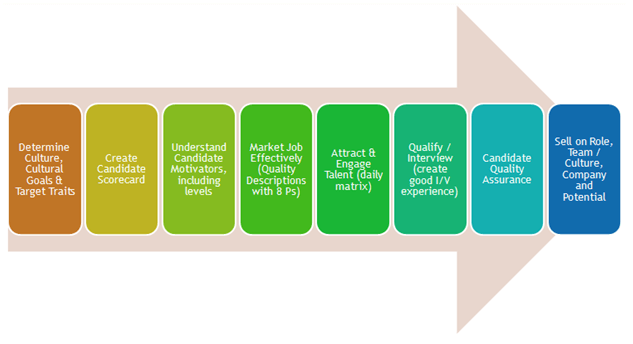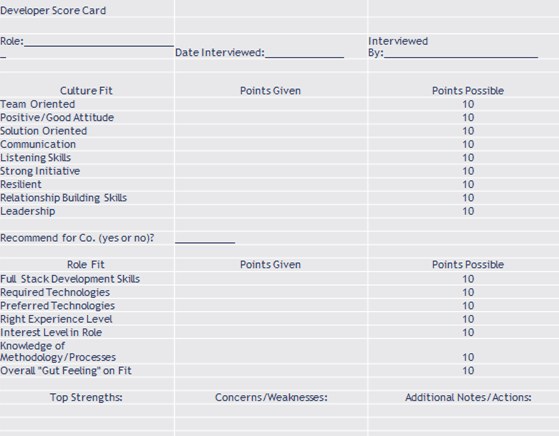By: Erica Woods | Comments | Related: More > Professional Development Interviewing
Problem
A top primary goal and challenge for any Manager is building and maintaining a strong team. There are various roadblocks that lead to personnel problems, such as talent shortages, supply vs. demand, competitive and more compelling offers, identifying the right people, igniting enough interest in those people so they interview and strongly consider your job, keeping them engaged throughout a lengthy interview and offer process, adequately screening candidates, and more. We had one client Manager we support recently inquire on this topic since he had 8 strong Developer candidates in a row decline his offer. Especially in the popular and growing field of Information Technology, organizations and hiring Managers need to create a strong hiring process that targets and reaches the right people, but also is appealing and delivers a good "interview experience" for candidates!
Solution
We've created an 8-step process/formula we recommend for identifying, engaging and attracting the top talent for your open positions. We continue to hear about the new trend of CX (customer experience). Here we define CX and IX strategies; the candidate and interview experiences.

Step 1: Determine "Culture Requirements"
You've likely heard that you want to find candidates who are both a fit for "your bus" (i.e. team, organization and culture) and for "that seat on the bus" (i.e. the individual role you're interviewing them for). If you haven't already, evaluate the current culture of your team and identify the common traits your key people have that you appreciate. What skills do they possess that make them top contributors? Then ensure you have at least one mechanism in place for how to assess that skill during the hiring/interview process.
Here are some example target skills and assessment mechanisms:
- Strong initiative - Ask candidates an interview question like "Tell me about a responsibility you had in your last job that wasn't part of your original job description."
- Helpful - Ask a former Manager a question during the reference check such as "On a scale of 1-10, how helpful was ___? What are some examples of what they'd do to help or support a team member or internal/external client?"
- Passionate - Ask candidate an interview question like "Are you involved in the local technical community at all?" or "How do you keep your technical skills fresh?" or "What excites you about your job?"
- Positive - Ask candidate a scenario-based interview question like "If you noticed that one of your peers who you're really close with is extremely negative during team meetings, and it negatively impacts the entire tone of the meeting, what would you do?"
You can also choose to do a brief exercise in a team meeting where you discuss your culture now, what you want your target culture to look like, what we could each do to contribute to that culture, and what skills we need to look for in future candidates to continue to build the type of culture and environment we want to work in.
Step 2: Create a Candidate Scorecard
Documentation is a precursor for success in a number of areas! During the hiring process, quality documentation comes into play when writing a job description and with candidate feedback capture. Therefore, make sure you're utilizing a scorecard that captures your feedback around the candidate's "culture fit" as well as "role fit" (i.e. how closely they align with the main requirements you need). Be diligent about completing a scorecard for each candidate you interview, and providing the completed scorecard back to the HR Representative/Corporate Recruiter or Staffing/Agency Recruiter you're partnering with.
By using a candidate scorecard, the positive results can include:
- Providing direction so you receive more applicable candidates in the future
- Helping provide feedback to the candidate, which is important to them, and something they want
- Helping the decision-making process if any of your peers want to consider that candidate now or in the future, especially if the candidate is deemed a culture fit
Here's an example candidate scorecard:

***Fun Fact: The 2015 global LinkedIn job seeker study found that candidates are 4x more likely to consider your company in the future if they receive tangible and constructive feedback after an interview!
Step 3: Understand Major Motivators
Do you have a grasp of the top motivators of your "target audience?" Do you know what aspects job seekers that fall into that skill set are looking for in an opportunity, technical stack/s, environment, company, manager, benefits, etc.? Remember that people have different motivators throughout their career, so take that into account! Also, motivators differ by generation.
We are constantly hearing from our hiring Managers:
- What are the motivators of millennial?
- How come employees in the millennial generation switch jobs so frequently?
- How can I appeal to the millennial audience throughout the interview process?
It's a helpful exercise to ask open-ended interview question/s, especially to candidates you really like, that provide insight into their individual motivators. For example:
- Direct questions such as "What benefits could a company provide that would be really valuable to you?" or "What makes a quality work environment for you?"
- Historical questions such as "Describe the best job you've ever had. What did you enjoy about it?"
- Scenario-based questions such as "Imagine you were designing your own team or company, and you had free reign to build the benefits package, training options, recognition programs, social events, and other perks. What are some of the programs and services you'd build out to create a quality and appealing environment?"
Step 4: Write a Quality Job Description
One of the biggest hurdles we see to good companies not attracting talent stems from a poorly written, vague, or blanket job description. Especially considering that the strongest candidates likely don't have a resume posted but are registered for job posting alerts, and that about 70% of job seekers are "passively" in the job market, a well-written job description that is an actual reflection of your current job opening is vital to appealing and engaging the right individuals for your role!
Another issue we see here is that job descriptions become a "wish list of requirements," focusing solely on what the Manager/Client needs, rather than a balance of the opportunity itself and the list of requirements. Remember to include some of the key information that candidates would care about, that would ignite interest and attract candidates to apply for your role.
So, what do candidates care about when evaluating job postings? It's helpful to "put yourself in the shoes of a job seeker" when reflecting on this!
Step 5: Attract and Engage Talent Using the Right Resources
The recruitment process can be tough, especially if you're seeking a niche or in demand skill set, specific requirements or other constraints. Therefore, make sure you're using the right resource channels. Some of the top recruitment channels include: referrals, user group/community involvement, partnering with a strong technical staffing/recruiting agency, job postings, LinkedIn, Indeed, and/or partnering with local Computer Science Clubs/Programs.
Once you've identified the best platforms for recruiting that skill set, take an effective approach with each channel you utilize. Here are some example approaches:
- Referrals – do you have a rewarding referral bonus structure in place? Are you effectively communicating when you have an opening? For example, instead of just sending an email to current team members, do you highlight the opening and the primary requirements and priorities in your next team meeting?
- Staffing firms – are you working with a firm who specializes in supporting that skill set? Are you communicating the "top 3-5 reasons candidates might be interested in that role?" Have you given them a quick tour and/or introduced them to other members of the team so they better understand, and can match, culture and environment?
- Computer Science Programs/Clubs – do you have a relationship with a coordinator or Board Member of the Club/Program? Do you have occasional coffee meetings with that individual to keep the relationship strong and determine how to best work together regarding your talent/resource needs?
- User Groups – do you share your openings via local SQL Server User Group meetings? When you have an opening, do you share it via your user group's social media channels? For example, you can share the link to the job via your Twitter handle and tag the handle of your local user group (if they have one), so they can share!
Step 6: Create an Effective and Positive Interview Experience
Once you identify and engage good candidates, you want to provide a quality interview experience. Especially after you've determined that the candidate is a strong technical and culture fit, meet their "interview needs" by providing enough insight on the opportunity, priorities, team size/dynamics/function, culture/environment, company overview, current vs. future roadmap, and more! Give candidates the opportunity to meet other individuals on the team who they'd be working alongside. If benefits are really important to the individual, ask an HR representative to be on stand-by, so they can provide a tour of the facility and an overview of the benefits offerings.
Step 7: Conduct "Candidate Quality Assurance"
For most hires, especially ones that are in key roles, will be doing heavy customer-interfacing, will be acting in senior or leadership capacities, etc. you want to take measures to validate their skills to help really ensure you're making the right hiring decision! Depending on the level of individual and the function they'll be doing, adjust your QA process.
Here are some example roles/levels and potential QA measures:
- Entry level/Junior technologists – initiative and learning potential is big here, so put together some sort of "homework assignment," which includes a "lessons learned" component.
- Lead/Manager candidates – ask for references of individuals who've managed them AND references of subordinates, people they've directly managed, people they've trained/mentored, etc. and assess their management skills/traits during a reference check.
- Senior Developers – review their Github profile, Stack Overflow contributions, or other community contributions. If they don't have recent code samples via those sites or a personal website, ask them to provide a code sample.
- Analysts – as part of the interview, give them a project overview and ask them to do a 15 minute requirements gathering session.
Step 8: Put on a "Marketing Hat"
Managers should view "marketing" as a part of their hiring responsibilities matrix! How do you market the role? Market the team and culture they'll work with? The perks and benefits of working at the organization? The project/s they'll get the opportunity to contribute to? The long-term learning and growth potential and career trajectory? Your marketing strategy will differ depending on the level of the individual and the role itself, so take 5 minutes or so on the frontend to identify your marketing strategy for that particular role and audience!
Next Steps
If you already don't view "building and maintaining a strong hiring process" as one of your responsibilities as a Manager, it's vital to adopt that mindset if you want a strong team. Furthermore, view that process as a constant evolution, and continue to assess and improve it!
If you're not sure where to start, in addition to the ideas provided in the solution above, here are some additional suggestions:
- Review any of your company feedback around interviews on Glassdoor, and identify any trends of issues from past interviewees that you could fix
- Schedule a brief meeting with your HR Representative/Corporate Recruiter and/or one of the staffing account representatives you work with to determine any feedback they might have for you on your hiring/interview process and suggestions for improvement
- Ask an open-ended question after your interview to strong candidates seeking to understand "what else could we have done to make the interview experience better for you?"
- Facilitate a short discussion in your next team meeting to determine suggestions for improving the interview experience, asking the team to come up with 1+ suggestion each for "How can we improve our overall hiring process? Improve our interview process? Improve the orientation and/or the first month on the job?"
Have other hiring and/or interview best practices? Share them in the Comments box!
About the author
 Erica Woods has nearly a decade in the IT staffing world, an MBA, and is a member of the Professional Association of Resume Writers and Career Coaches.
Erica Woods has nearly a decade in the IT staffing world, an MBA, and is a member of the Professional Association of Resume Writers and Career Coaches.This author pledges the content of this article is based on professional experience and not AI generated.
View all my tips






